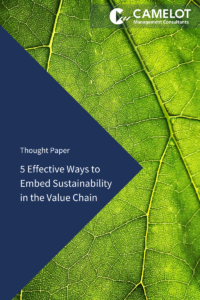What we can learn from the corona pandemic in the fight against climate change and why now is the time to prepare for a climate-neutral future.
The corona crisis has impressively shown us that when we must, our societies can act surprisingly fast and with determination to protect our health and well-being. That – together with the unprecedented solidarity and support of private persons and companies alike – is a very encouraging signal. “Flatten the curve” has become the symbol of globally minding science and solidarity on many levels. However, the current crisis has also raised our awareness around critical system capacities, and how approaching or exceeding them can trigger instability and many unwanted spill-over and ripple effects: take for example states and nations scrambling to get access to critical equipment such as ventilators and protective equipment.
Are we able to transfer some of the insights we gained from handling the COVID-19 situation to the climate change problem? On a first glance there appear to be several similarities between these two challenges. Firstly, there is a clear consensus in the scientific community regarding the severity of both problems and the need for immediate action. Secondly, like understanding the capacity of our healthcare systems in the context of the corona crisis, there is also a clear and quantitative understanding of the earth’s capacity to absorb more CO2 emissions before our climate is severely impacted. This capacity currently amounts to a remaining budget of a global total of 322 gigatons of CO2 equivalents if we want to limit global warming to 1.5°C compared to pre-industrial levels[1]. If we follow this budget but continue with emissions at the current level, then in approximately 7.5 years as of May 2020 the 1.5°C threshold is exceeded.
Of course, there are also some reasons why the climate crisis has so far failed to trigger the same determined and fast response we have seen in the corona pandemic. Reasons are mainly that the implications of climate change are much more complex, gradual, and interdependent, and are perceived by many as a less immediate threat with often unclear direct personal consequences. Still, we think companies must learn from the current situation and develop new and more determined ways to address the sustainability footprint of their value chains. We think companies should consider five major steps to bring their sustainability strategies to the next level and become true frontrunners in the fight against climate change:
- Create tangible CO2 footprint transparency for decision-makers
- Conduct strategic scenario planning based on sustainability
- Put a price tag on emissions to incentivize actions and creativity
- Use unconventional approaches to flatten the curve
- Engage employees and external partners to make a difference
Create tangible footprint transparency for decision-makers
In the last years, we have seen progress in companies’ transparency of CO2 footprint mapping, as can be witnessed by many sustainability reports and the increasing traction of voluntary information sharing like the Carbon Disclosure Project. However, we think it is fair to say that sustainability metrics are still not sufficiently integrated into day-to-day planning and decision-making in companies’ value chains. We need to elevate CO2 emissions and other sustainability metrics from abstract reporting to tangible input for decision-makers along the value chain. A critical prerequisite for that is an increased level of CO2 footprint transparency using analytics and giving easy access to emissions and energy usage data to managers in commercial affiliates, stores, production sites, and suppliers. Only with that level of transparency, sustainability will enter the decision-making arena for strategy, procurement, manufacturing, and supply chain, and allow value chain practitioners to define targets and properly evaluate trade-offs including ecology and economy.
Conduct strategic scenario planning based on sustainability
The above-mentioned CO2 budget and a series of accelerating disruptions (e.g., wildfires, droughts, summer heatwaves) proves that the impacts of the climate change are already noticeable and should therefore play a major factor in any company’s strategic planning horizon. However, only 42% of all companies surveyed by the Carbon Disclosure Project[2] conduct climate-related scenario planning and many of those only qualitatively. Thus, we need to elevate climate-related planning from a purely environmental function to a key ingredient of corporate strategy. Business strategy, value chain strategy and CAPEX planning, among others, should be informed about quantitative climate-related scenarios. This includes not only the impact assessment of energy/CO2 taxation and regulatory developments but also scenarios for climate-related risk events and shifts in decision patterns of consumers, investors, partners and other important external stakeholders.
Put a price tag on emissions to incentivize creativity
Environmental issues and greenhouse gas emissions have typically been externalities which do not impact the companies’ financial performance. This situation is gradually changing, with political actions such as the European emissions trading systems or the CO2 tax being imposed in many countries. Still, the existing external pricing signals are often insufficient to incentivize companies’ aspirational journey towards a low-carbon economy. To raise the incentives, more companies should consider the implementation of internal carbon pricing for emissions along their value chain. Carbon pricing or other incentivization mechanisms – e.g., funds for incentivizing carbon reduction measures of suppliers – can be designed to balance ecology and economy in procurement, capital expenditure projects, and operational decisions in the value chain and commercial.
Carbon pricing is an important concept which is gaining traction but still has a lot of room for growth. In its report on carbon pricing in October 2017, the Carbon Disclosure Project counted 600 companies using internal carbon pricing in their business plans, a 4-times increase over 3 years[3]. Equally interesting, the Carbon Pricing Dashboard of the World Bank shows as of today many regional, national, and sub-national carbon pricing initiatives globally, which are covering approximately 21% of global emissions[4]. Thus, both on the corporate and governmental side, carbon pricing has still a lot of potential for growth.
Use unconventional approaches to flatten the curve
Companies need to think bold and define their individual path to climate-neutral, starting now until 2030 (response horizon based on remaining carbon budget) and 2040 (vision for a zero-carbon future). We need to acknowledge that single measures will not solve the challenge: neither radical behavior change nor investing in new breakthrough technologies will be the sole savior. Therefore, companies need to think holistically and use a broad portfolio of measures. We group these measures in four big categories:
- Act smart and sustainable: Increase of work share in the home office; smart business travel (minding good ratio of meeting and travel time, else moving to virtual collaboration); waste avoidance in materials, consumables, catering.
- Resource efficiency and circular use: Process development and optimization; re-use and commercialization of own process waste; capturing and re-use of process heat; incentivize sourcing of products with a high share of circular materials; recycling of durables like appliances and electronics; move from buying to sharing; energy efficiency through efficient devices, insulation, facility design, steering of usage, analytics.
- Use existing renewable energy technologies: Maximum leverage of existing technologies like wind, solar, biogas through own installations and upgrades, or else power purchase agreements, accompanied by investments in energy storage and power to X technologies (e.g., Power to gas, Power to steam, molten salt energy storage, battery technology)
- Invest in new breakthrough technologies: Invest in new potential breakthrough technologies which are not yet ripe for use at scale or still require long-term infrastructure investments, e.g., green hydrogen use in power plants or fuel cells, carbon sequestration and storage or use in agriculture.
Companies need their individual and tailored sustainability strategy which balances climate impact with OPEX and CAPEX impact across a portfolio of measures. Whereas many CO2 measures require significant pre-investment and lead to increased cost, others can also help save cost and provide additional funds for investing in a more sustainable value chain.
Engage employees and external partners to make a difference
Your path to climate-neutral is a true team effort and >80% of the success will be owed to the engagement of people, both of employees and external partners. Surveys show impressively the importance of environmental protection and sustainability, and especially for the younger generations (Generation Z and Millennials) sustainability is becoming a non-negotiable requirement.[5] However, more importantly, effectively engaging your team from idea-generation over strategy definition to implementation can boost your path to climate-neutral and set free unprecedented energy and momentum.
Equally important are effective approaches to make your external suppliers and partners an integral part of your sustainability effort. Depending on industrial value chain structures and the share of outsourcing, the emissions from external sourcing (Scope 3 emissions) will have a share of 50–90% of the total CO2 footprint, in industries like consumer goods as high as 95%. Thus, effective approaches for emissions transparency of suppliers, target setting, knowledge sharing, as well as incentivization and penalty mechanisms need to be integrated into sourcing strategies and supplier management routines.
By moving to climate-neutral value chains, companies have the lever to make a difference in the global fight against climate change, accelerate new business models, and protect their competitive advantage for the future. To achieve that target, they need to understand sustainability as an integral part of operational and strategic decision-making, define a holistic and aspirational strategy towards 2030/2040, and effectively engage their employees and external partners to green the E2E value chain.
If you wish to explore this topic in more detail, check out our GreenMind2 webpage or simply get in touch with us.
We would like to thank the following CAMELOT GreenMind2 team members for their valuable contributions to this article: Georg Bienert, David Dickmann, Anton Köther, Kilian Lück, Jonas Rethmann, Brita Rohrbeck.
[1] Mercator Research Institute; https://www.mcc-berlin.net/en/research/CO2-budget.html
[2] CDP Global climate change analysis 2018; https://www.cdp.net/en/research/global-reports/global-climate-change-report-2018
[3] CDP, Putting a price on carbon, October 2017
[4] https://carbonpricingdashboard.worldbank.org/
[5] Bundesministerium für Umwelt, Naturschutz und nukleare Sicherheit „Umweltbewusstsein in Deutschland“ https://www.umweltbundesamt.de/sites/default/files/medien/2294/dokumente/4_ubs_2018_zentrale_befunde.pdf
We would like to thank Stefan Dittrich for his valuable contribution to this article.


